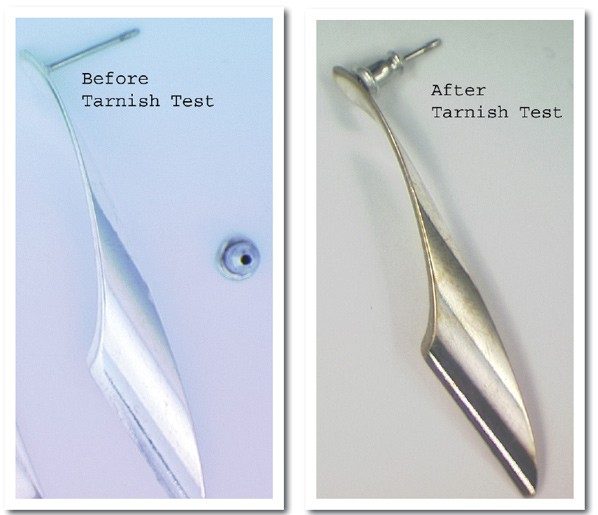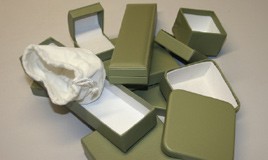Meet the Experts full package
The full package

Packaging can be an essential part of a product, not only protecting the article from damage but enhancing its presentation to the customer. But, says Assay Office Birmingham’s technical director DIPPAL MANCHANDA, it needs to be made of the right stuff for a host of reasons...

In addition to the packaging adding status and value to a product it is essential to ensure that it is fit for purpose and also that it complies with EU legislation. One of the most frequent causes of tarnishing is a component of the packaging such as sulphur rich glue. There is also a requirement for packaging to be used within the EU to comply with the Packaging Directive which has been in force since 1994. AnchorCert Analytical has developed tests to allow them to work with customers to overcome tarnishing issues and ensure their packaging is compliant to Article 11 of the Packaging Directive, concentration of levels of heavy metals.
Tarnishing
Tarnishing is an ongoing problem, particularly for silver and low carat gold articles. Silver naturally interacts with oxygen and pollutants to create silver sulphide, resulting in a visible discolouration of the metal’s surface. Research has proved that some elements of packaging can cause or significantly accelerate tarnishing. Silver tarnishes in environments containing various sulphuric gases, even in very low concentration. The amount of tarnishing is determined by the relative humidity, ambient temperature, the concentration of sulphur and other tarnishing causing compounds, and the length of time the silver is exposed to the gases.
 Paper and cardboard and certain cloths, foams and adhesives, used to protect and display the product as part of the packaging presentation can themselves be a tarnishing accelerant. Most types of paperboard in contact with silver, copper and certain copper zinc based low carat gold alloys cause localised tarnish stains on the metal surface. The tarnishing agent is most likely to be reducible sulphur or a volatile sulphur-liberating compound which can still cause problems even if not in direct contact with the product. The vapour-phase action of sulphur compounds mean they will penetrate through the paper to the metal surface.
Paper and cardboard and certain cloths, foams and adhesives, used to protect and display the product as part of the packaging presentation can themselves be a tarnishing accelerant. Most types of paperboard in contact with silver, copper and certain copper zinc based low carat gold alloys cause localised tarnish stains on the metal surface. The tarnishing agent is most likely to be reducible sulphur or a volatile sulphur-liberating compound which can still cause problems even if not in direct contact with the product. The vapour-phase action of sulphur compounds mean they will penetrate through the paper to the metal surface.
Moisture may also be a vital ingredient and is particularly relevant when articles are shipped by sea through humid conditions. Paper/ paperboard containing 0.5 or 2.5% sodium sulphide or other sulphur compounds will only cause silver to tarnish in a moist atmosphere. The tarnishing of silver, copper and certain copper-zinc alloys can be avoided with certainty only if a free sulphur content of less than 0.0008% is guaranteed for the paper or board. Recycled paper and cardboard are preferable as they have lower sulphur content than virgin paper as well as lower levels of other harmful tarnishing causing constituents.
However, sulphur is not the only problem. All wood products have some level of formaldehyde present, which converts to formic acid over time and increases the acidity of the paper product. Unless manufacturers employ rigorous quality control practices to their input stock paper and board, large variations in the tarnish causing constituent can occur.
“Acid free” paper is preferable but even so, some samples have been found to contain high concentrations of sulphur and other contaminants. The source of tarnishing can be any one of the several packaging components used. When an item is contained in a small, sealed environment with sulphur releasing agents such as sulphurous adhesives, the levels of sulphur can become concentrated, especially in warm humid conditions. Research shows that even one small adhesive label can have dramatic eff ects as can some synthetic foams and bubble wraps which may release tarnish accelerating chlorides and fluorides.
Testing packaging to identify tarnish accelerants
The unique accelerated tarnish test for packaging materials, developed by experts at AnchorCert Analytical identifies the presence or absence of components responsible for causing tarnishing or staining of products. This test is primarily for packaging that is in direct contact with silver, low carat gold and base metal items. Carefully controlled test conditions cause the control sample of uncoated silver to tarnish if volatile sulphides or any other compounds which cause tarnishing are present, This is an “early warning” system for retailers, preventing unsuitable packaging from causing large shipments to tarnish and become unsaleable.
EU PACKAGING DIRECTIVE
The EU Packaging directive directive 94/62/eC regulates all packaging placed on the Eu market and all packaging waste. In contrast to tarnishing issues the directive is concerned with the environmental impact of packaging after use. the legislation covers all packaging for all items and lays down essential requirements including those related to marking and identification, i.e. labelling of materials. to facilitate collection, reuse and recovery (including recycling), packaging can be marked in such a way that it is possible to identify and classify the nature of the packaging material. The European standardisation body (CEN) formulated six European standards that further specified the essential requirements of directive 94/62/EC. The identification system is currently voluntary but many European suppliers have accepted this as the norm and are following the regulations as a matter of course.
In order to try to limit long term detrimental impact on the environment certain heavy metals are restricted under Article 11 of the Packaging directive. A maximum concentration level of a total of 100 ppm by weight is set for lead, cadmium, hexavalent chromium and mercury in packaging or packaging components. this is a low limit, lower than that allowed in the jewellery or watch which may be contained in the packaging in some cases. It needs expertise and an understanding of the legislation in order to test accurately. Our experts team has all the necessary expertise to deliver an accurate independent, UKAS accredited report which will carry authority throughout the EU.
Suppliers do need to take note because this legislation is being enforced. The RAPEX alert system, an EU wide bulletin that advises of items withdrawn from the market due to consumer product safety issues frequently reports issues with packaging. for example in march 2014, fancy dress costumes were withdrawn from the market in Sweden providing a warning for the industry throughout the EU. The outfits were withdrawn because the plastic in the packaging contained cadmium above the permitted levels (measured value: up to 251 mg/kg).
Your item has been added to the basket
You need to create an account, or login before you can add this item to your basket.

 Dippal Manchanda is the chief assayer and technical director at Assay Office Birmingham, responsible for maintaining high analytical standards and providing scientific and technical expertise to all divisions of the business. Dippal holds a Masters degree (MSc) in inorganic chemistry and has over 20 years of experience in assaying and the examination of precious metals and alloys. He is also a Fellow of the Royal Society of Chemistry and has attained the level of membership of ‘Chartered Chemist’. The UK Science Council has awarded him the status of ‘Chartered Scientist’ – a recognition awarded to those scientists who demonstrate the application to stay up to date in their field. During his varied career, Dippal has been involved in several prestigious precious metal projects including setting up a state-of-the-art gold/silver medallion manufacturing facility for a public sector undertaking in India.
Dippal Manchanda is the chief assayer and technical director at Assay Office Birmingham, responsible for maintaining high analytical standards and providing scientific and technical expertise to all divisions of the business. Dippal holds a Masters degree (MSc) in inorganic chemistry and has over 20 years of experience in assaying and the examination of precious metals and alloys. He is also a Fellow of the Royal Society of Chemistry and has attained the level of membership of ‘Chartered Chemist’. The UK Science Council has awarded him the status of ‘Chartered Scientist’ – a recognition awarded to those scientists who demonstrate the application to stay up to date in their field. During his varied career, Dippal has been involved in several prestigious precious metal projects including setting up a state-of-the-art gold/silver medallion manufacturing facility for a public sector undertaking in India.